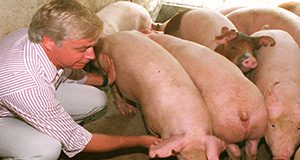La Ley de Modernización de la Seguridad Alimentaria (FSMA) se convirtió en ley en enero de 2011 y se considera la reforma más amplia de las normas de seguridad alimentaria en 70 años. Primero, se establecieron las regulaciones sobre alimentos para el consumo humano luego con la contribución de la industria, la academia, y los consumidores y otras agencias, se modificaron para adaptarse mejor a la producción de alimentos para animales. En Florida, estas nuevas regulaciones se aplican a las instalaciones que fabrican, procesan, empacan o almacenan alimentos o ingredientes para animales. El objetivo principal de estas regulaciones es garantizar alimentos seguros para los animales, las personas que manejan el alimento y las personas que consumen productos derivados de animales. This 4-page document is the Spanish version of The Food Safety Modernization Act (FSMA) Preventive Controls for Animal Food. Written by Francisco Rivera, Chad Carr, and Jason M. Scheffler, and published by the UF/IFAS Department of Animal Sciences, February 2019.
http://edis.ifas.ufl.edu/an352
Tag: FSMA
The Food Safety Modernization Act (FSMA) Preventive Controls for Animal Food
The Food Safety Modernization Act (FSMA) was signed into law in January of 2011 and is considered the most sweeping reform of food safety regulations in 70 years. The human food regulations were composed first and, with significant input from industry, academia, and consumer groups as well as other agencies, were then modified to better suit animal food production. In Florida, these new regulations apply to facilities that manufacture, process, pack, or hold food or food ingredients for animals. These facilities may include pet food manufacturers, renderers, ethanol distillers, feed mills, distributors, and others. The primary goal of these regulations is to ensure safe food for the animals, people who handle the feed, and people who consume the final animal products. This 3-page fact sheet discusses requirements, facilities that will most likely be expected to be in compliance, deadlines, development of a food safety plan, and preventive controls qualified individuals. Written by Jason M. Scheffler and Chad Carr, and published by the UF Department of Animal Sciences, December 2016.
http://edis.ifas.ufl.edu/an330
The Cost of Food Safety
 This new publication discusses the costs and long-term benefits associated with the implementation of food safety programs. This 5-page fact sheet covers the history of HACCP, costs associated with the application of food safety programs, reasons to improve food safety, and the financial impact of foodborne illnesses. Written by Annelys Hessing, Renée Goodrich Schneider, Alan Gutierrez, Rachael Silverberg, Michael S. Gutter, and Keith R. Schneider, and published by the UF Department of Food Science and Human Nutrition, October 2015.
This new publication discusses the costs and long-term benefits associated with the implementation of food safety programs. This 5-page fact sheet covers the history of HACCP, costs associated with the application of food safety programs, reasons to improve food safety, and the financial impact of foodborne illnesses. Written by Annelys Hessing, Renée Goodrich Schneider, Alan Gutierrez, Rachael Silverberg, Michael S. Gutter, and Keith R. Schneider, and published by the UF Department of Food Science and Human Nutrition, October 2015.
http://edis.ifas.ufl.edu/fs270

